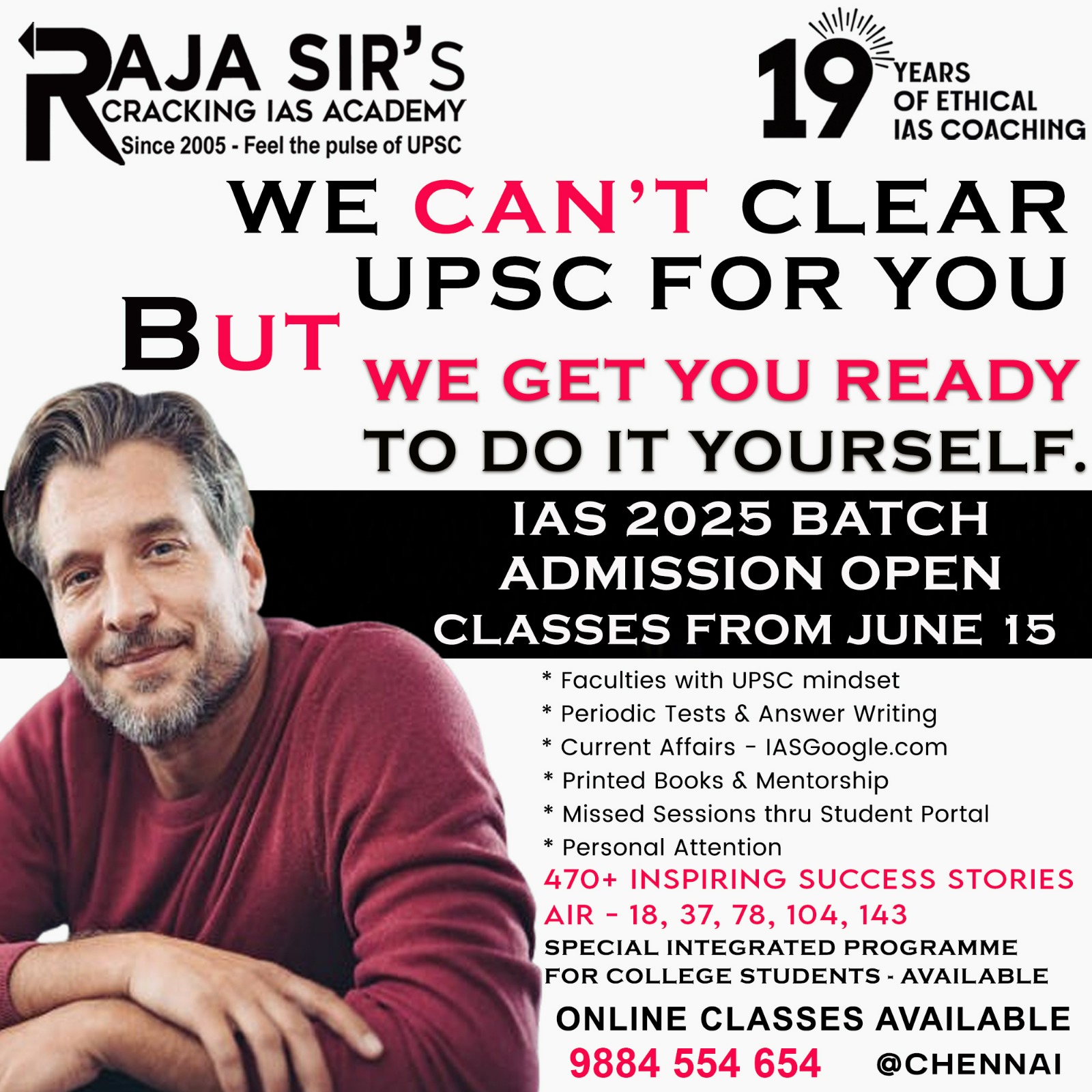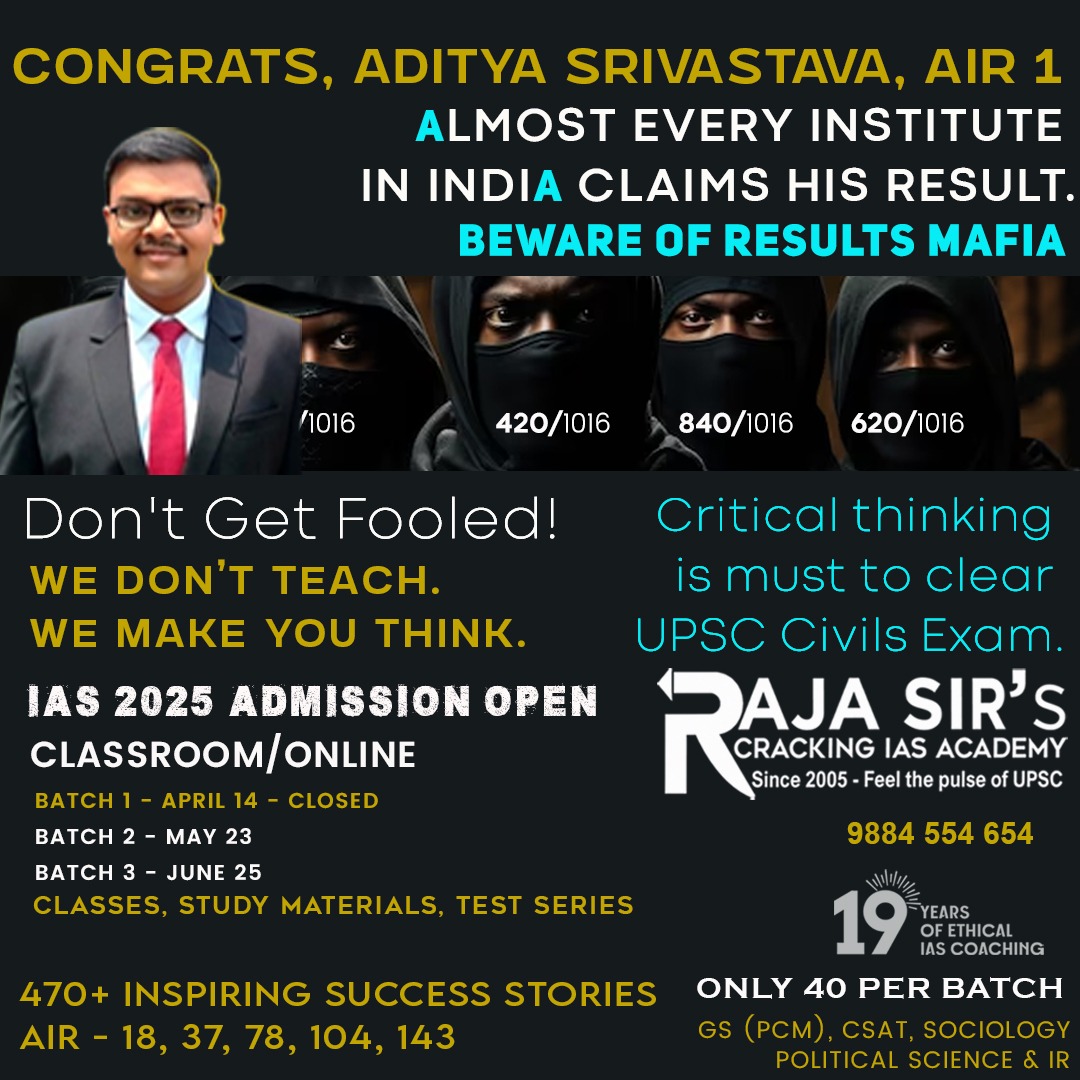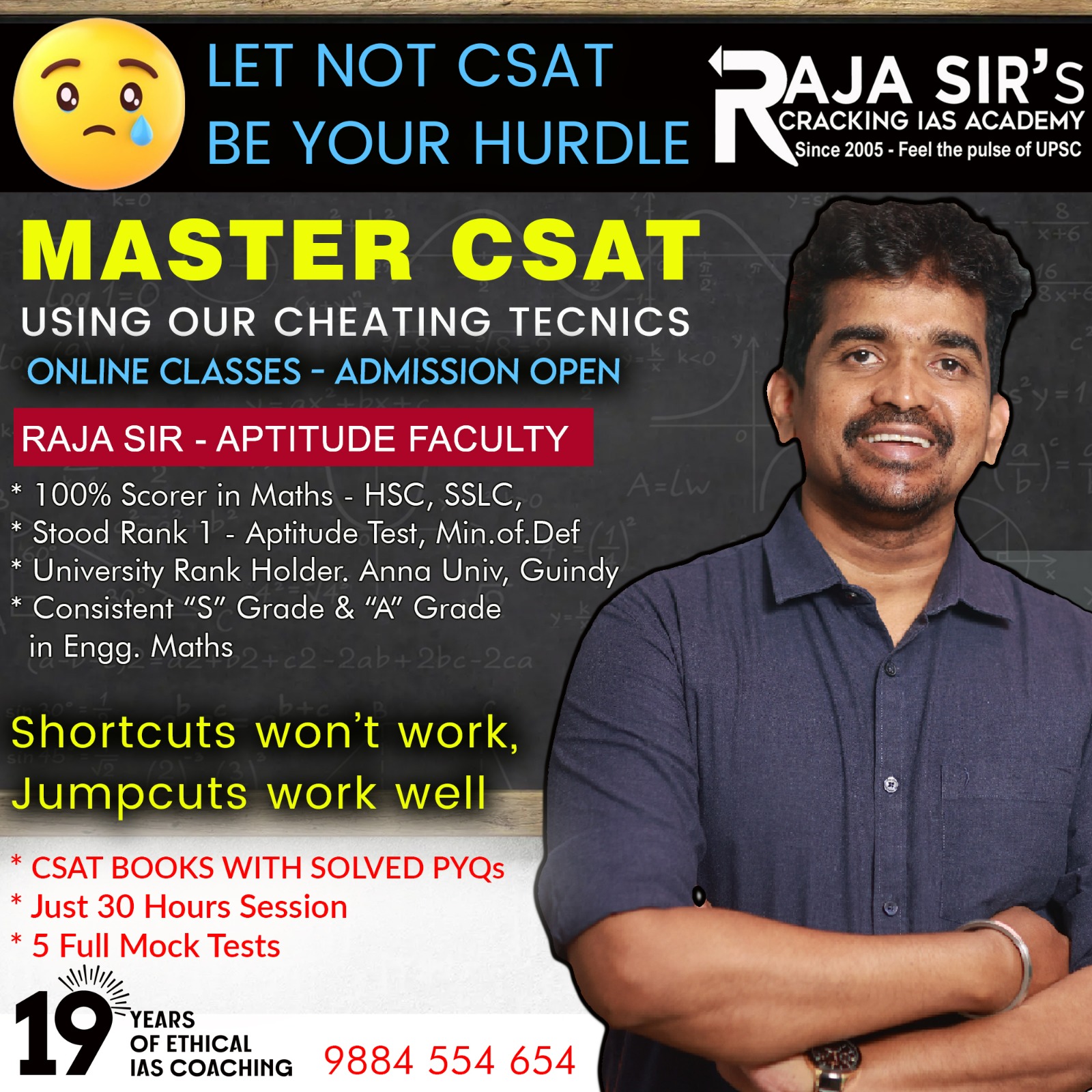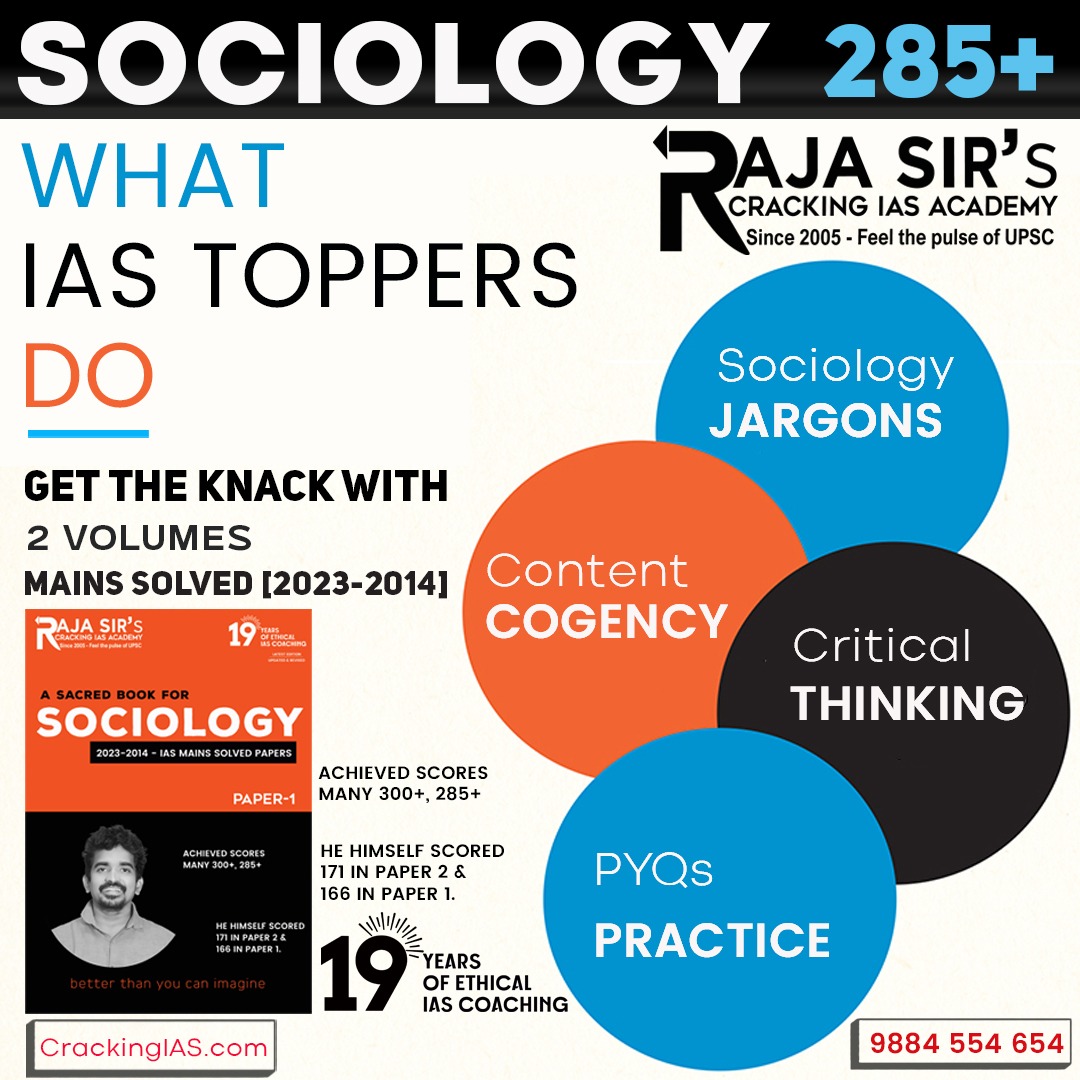- Home
- Prelims
- Mains
- Current Affairs
- Study Materials
- Test Series
Hit List Questions 73-PPP100 PRELIMS 2024 - 91
Questions & Explanations:
|
1. |
‘Treaty of Bassein’ was signed between (a) English and Bajirao- I (b) English and Bajirao- II (c) French and Bajirao- I (d) Dutch and Bajirao- II
|
|
|
2. |
1. It is a statutory body. 2. It is a body that shall be constituted by the State Government in consultation with the Governor of the state. Which of the above statements is/are correct w.r.t. District Legal Services Authority? (a) 1 only (b) 2 only (c) Both 1 and 2 (d) Neither 1 nor 2
|
|
|
3. |
1. It was abolished by Warren Hastings. 2. It was established by Robert Clive. Which of the above statements is/are correct w.r.t. Dual government of Bengal? (a) 1 only (b) 2 only (c) Both 1 and 2 (d) Neither 1 nor 2
|
|
|
4. |
1. The Conference of Parties is the decision-making organ of this convention. 2. India is yet to become a party to it. Which of the above statements is/are correct w.r.t. Convention on the Conservation of Migratory Species of Wild Animals known as Bonn Convention? (a) 1 only (b) 2 only (c) Both 1 and 2 (d) Neither 1 nor 2
|
|
|
5. |
Brickwork Ratings is related to (a) Energy grading in Green Buildings (b) Conservation of Cultural Heritage (c) Credit Rating (d) Electric Vehicle standards
|
|
|
6. |
Consider the following statements about the “Global Environment Facility (GEF)”. I. It was established on the eve of the 1992 Rio Earth Summit of UNFCCC. II. India is an observer in it. III. It provides financial assistance for The Minamata Convention on Mercury. Which of the statements given above is/are incorrect? (a) Only I (b) Only I and III (c) Only I and II (d) None of the above
|
|
|
7. |
Consider the following statements regarding Cornwallis: - 1. He signed Mangalore Treaty 2. He separated the judiciary from the executive. Which of the statements given above is/are correct?. (a) 1 only (b) 2 only (c) Both 1 and 2 (d) Neither 1 nor 2
|
|
|
8. |
1. It is the moon of Saturn. 2. It lacks Phosphorus, a vital element for life. Which of the above statements is/are false w.r.t. Enceladus.?. (a) Only 1 (b) Only 2 (c) Both 1 and 2 (d) Neither 1 nor 2
|
|
|
9. |
Consider the following statements w.r.t. Nano Urea. 1. It contains 4.0 % total nitrogen (w/v). 2. It is included in the Fertilizer Control Order. (a) Only 1 is true (b) Only 2 is true (c) Both 1 and 2 are true (d) Neither 1 nor 2 is true
|
|
|
10. |
Cry2Ai in news is a/an (a) NGO (b) UN initiative to educate street children (c) Transgenic crop (d) Fortified rice
|
|
|
11. |
From the options given below, find the correct combination of the names of editors of the nationalist newspapers Bengalee, Hindustani, Sudharak: (a) Surendranath Benerjee, Ganga Prasad Verma, Gopal krishna Gokhale (b) Surendranath Banerjee, Taraknath Das, Jyothibha Phule (c) Surendranath Banerjee, Taraknath Das, Ambedkar (d) Surendranath Benerjee, Ganga Prasad Verma, Keshab Chandra Sen
|
|
|
12. |
I. It is imposed to prevent low-priced foreign goods from damaging the local market. II. The World Trade Organization permits its imposition. Which of the above statements is/are true w.r.t. Countervailing duty?. (a) Only I (b) Only II (c) Both I & II (d) Neither I nor II o |
|
|
13. |
Maghazi and Jabalia refugee camps are in (a) South Sudan (b) Egypt (c) Gaza (d) Somalia
|
|
|
14. |
The correct chronological order of the subsidiary alliance treaties 1. Hyderabad 2. Mysore 3. Oudh 4. Scindhia (a) 1,2,3,4 (b) 1,3,4,2 (c) 4,3,2,1 (d) 3,2,1,4
|
|
|
15. |
Where is “Reasi Sersandu-Kherikot-Rahotkot-Darabi” mineral block?. (a) Odisha (b) Ladakh (c) Kashmir (d) Jharkhand
|
|
|
16. |
Which of the following is/are not true?. I. When carbon dioxide molecules about 90 kilometres above Earth become excited during an aurora, they emit radio waves. II. Aurora borealis happen in the Southern Hemisphere; III. Aurora australis happen in the Northern Hemisphere. Codes: (a) Only II (b) Only I and II (c) Only II and III (d) I, II and III
|
|
|
17. |
Which of the following is/are true w.r.t. Sundargarh natural arch? 1. It is present in ferruginous sandstone of Upper Kamthi formation. 2. The arch will be safeguarded under Indian Treasure Trove Act, 1878. (a) 1 only (b) 2 only (c) Both 1 and 2 (d) Neither 1 nor 2
|
|
|
18. |
Which one of the following is the correct chronological order of the battles fought in India in the 18 Century? (a) Battle of Wandiwash-Battle of Buxar-Battle of Ambur- Battle of Plassey (b) Battle of Ambur-Battle of Plassey-Battle of Wandiwash-Battle of Buxar (c) Battle of Wandiwash-Battle of Plassey-Battle of Ambur-Battle of Buxar. (d) Battle of Ambur-Battle of Buxar-Battle of Wandiwash- Battle of Plassey.
|
|
|
19. |
Who was defeated by General Napier‘s troops and was executed by the British Government at Shivpuri on 18th April 1859?. (a) Kunwar Singh (b) Tantya Tope (c) Maulavi Ahmadullah Shah (d) Azimullah Khan
|
|
|
20. |
With reference to the Sickle Cell anaemia, consider the following statements: 1. A person will be born with sickle cell disease only if two genes are inherited—one from the mother and one from the father. 2. It is caused by a mutation in the hemoglobin-β gene found on chromosome 11. Which of the statements given above is/are correct? (a) Only 2 (b) Only 1 (c) Both 1 and 2 (d) Neither 1 nor 2
|
|
|
21. |
‘Bhartiya Brahmo Samaj’ was founded by (a) Devendranath Tagore (b) Ishwar Chandra Vidyasagar (c) Keshab Chandra Sen (d) Raja Ram Mohan Roy
|
|
|
22. |
1. It is a legally non-binding treaty 2. It is built on the legacy of the UN Convention on the Law of the Sea. Which of the above statements is/are correct w.r.t. Paris Agreement for the Ocean? (a) 1 only (b) 2 only (c) Both 1 and 2 (d) Neither 1 nor 2
|
|
|
23. |
1. It is proposed in the Information Technology Rules, 2021. 2. It can take Suo Motu cognizance. Which of the above statements is/are correct w.r.t. fact-check unit? (a) 1 only (b) 2 only (c) Both 1 and 2 (d) Neither 1 nor 2
|
|
|
24. |
1. The Carnatic Wars established British supremacy in trade in India. 2. The Battle of Plassey laid the foundation of British Empire in India. 3. The Battle of Buxar established the British as masters of Bengal, Bihar and Orissa. 4. The Battle of Wandiwash was, a confrontation between Thomas-Arthur, Comte de Lally and Eyre Coote. The correct statements are (a) 1, 2, 3 and 4 (b) 1 and 4 only (c) 1 and 3 only (d) 2 and 4
|
|
|
25. |
Betelgeuse in news is a/an (a) insect (b) tree (c) star (d) island
|
|
EXPLANATIONS
|
1. |
The Treaty of Bassein (Now called Vasai) was a pact signed on December 31, 1802 between the English East India Company and Bajirao II, the Maratha Peshwa of Pune (Poona) in India after the Battle of Poona. In this treaty, Bajirao-II was restored as Peshwa in Pune with around 60 thousand English forces were permanently stationed with the Peshwa to protect him for which 26 lakh was to be paid to East India Company. |
B |
||||||||||||||||||||||||||||||||||||||||||||||||||||||||||||||||||||||||||||||||||||||||||||||||||||||||||||||||||||||||||||||||||||||||||||||||||||||||||||||||||||||||||||||||||||||||||||||||||||||||||||||||||||||||||||||||||||||||||||||||||||||||||||||||||||||||||||||||||||||||||||||||||||||||||||||||||||||||||||||||||||||||||||||||||||||||||||||||||||||||||||||||||||||||||||||||||||||||||||||||||||||||||||||||||||||||||||||||||||||||||||||||||||||||||||||||||||||||||||||||||||||||||||||||||||||||
|
2. |
https://iasgoogle.com/n/june-6-current-affairs-2023 It is a body that shall be constituted by the State Government in consultation with the Chief Justice of the High Court. |
A |
||||||||||||||||||||||||||||||||||||||||||||||||||||||||||||||||||||||||||||||||||||||||||||||||||||||||||||||||||||||||||||||||||||||||||||||||||||||||||||||||||||||||||||||||||||||||||||||||||||||||||||||||||||||||||||||||||||||||||||||||||||||||||||||||||||||||||||||||||||||||||||||||||||||||||||||||||||||||||||||||||||||||||||||||||||||||||||||||||||||||||||||||||||||||||||||||||||||||||||||||||||||||||||||||||||||||||||||||||||||||||||||||||||||||||||||||||||||||||||||||||||||||||||||||||||||||
|
3. |
Dual government of Bengal After the Battle of Buxar, the East India Company emerged as the dominant power in Bengal. Robert Clive introduced the dual system of government, where both the Company and the Nawab had a role in governing Bengal.
Failure of the Dual GovernmentThe dual system led to an administrative breakdown and had disastrous consequences for the people of Bengal. Neither the Company nor the Nawab prioritised administration and public welfare. Warren Hastings eventually abolished the dual system in 1772.
Abolition of the Dual GovernmentAs the Company''s Governor-General, Warren Hastings arrived in India in 1772 with clear directives from the Directors to abolish the Dual Government.
|
C |
||||||||||||||||||||||||||||||||||||||||||||||||||||||||||||||||||||||||||||||||||||||||||||||||||||||||||||||||||||||||||||||||||||||||||||||||||||||||||||||||||||||||||||||||||||||||||||||||||||||||||||||||||||||||||||||||||||||||||||||||||||||||||||||||||||||||||||||||||||||||||||||||||||||||||||||||||||||||||||||||||||||||||||||||||||||||||||||||||||||||||||||||||||||||||||||||||||||||||||||||||||||||||||||||||||||||||||||||||||||||||||||||||||||||||||||||||||||||||||||||||||||||||||||||||||||||
|
4. |
A |
|||||||||||||||||||||||||||||||||||||||||||||||||||||||||||||||||||||||||||||||||||||||||||||||||||||||||||||||||||||||||||||||||||||||||||||||||||||||||||||||||||||||||||||||||||||||||||||||||||||||||||||||||||||||||||||||||||||||||||||||||||||||||||||||||||||||||||||||||||||||||||||||||||||||||||||||||||||||||||||||||||||||||||||||||||||||||||||||||||||||||||||||||||||||||||||||||||||||||||||||||||||||||||||||||||||||||||||||||||||||||||||||||||||||||||||||||||||||||||||||||||||||||||||||||||||||||
|
5. |
https://iasgoogle.com/n/june-7-current-affairs-2023 The credit rating agencies in India are authorized and regulated by the Securities and Exchange Board of India as per the SEBI Regulations, 1999 of the SEBI Act, 1992. There are seven top credit rating agencies in India namely
|
C |
||||||||||||||||||||||||||||||||||||||||||||||||||||||||||||||||||||||||||||||||||||||||||||||||||||||||||||||||||||||||||||||||||||||||||||||||||||||||||||||||||||||||||||||||||||||||||||||||||||||||||||||||||||||||||||||||||||||||||||||||||||||||||||||||||||||||||||||||||||||||||||||||||||||||||||||||||||||||||||||||||||||||||||||||||||||||||||||||||||||||||||||||||||||||||||||||||||||||||||||||||||||||||||||||||||||||||||||||||||||||||||||||||||||||||||||||||||||||||||||||||||||||||||||||||||||||
|
6. |
https://iasgoogle.com/current_affair/june-29-current-affairs-2023 |
B |
||||||||||||||||||||||||||||||||||||||||||||||||||||||||||||||||||||||||||||||||||||||||||||||||||||||||||||||||||||||||||||||||||||||||||||||||||||||||||||||||||||||||||||||||||||||||||||||||||||||||||||||||||||||||||||||||||||||||||||||||||||||||||||||||||||||||||||||||||||||||||||||||||||||||||||||||||||||||||||||||||||||||||||||||||||||||||||||||||||||||||||||||||||||||||||||||||||||||||||||||||||||||||||||||||||||||||||||||||||||||||||||||||||||||||||||||||||||||||||||||||||||||||||||||||||||||
|
7. |
The Treaty of Mangalore was signed between Tipu Sultan and the British East India Company on 11 March 1784. It was signed in Mangalore and brought an end to the Second Anglo-Mysore War. https://iasgoogle.com/editorial/lord-cornwallis-1786-ndash-1793 |
B |
||||||||||||||||||||||||||||||||||||||||||||||||||||||||||||||||||||||||||||||||||||||||||||||||||||||||||||||||||||||||||||||||||||||||||||||||||||||||||||||||||||||||||||||||||||||||||||||||||||||||||||||||||||||||||||||||||||||||||||||||||||||||||||||||||||||||||||||||||||||||||||||||||||||||||||||||||||||||||||||||||||||||||||||||||||||||||||||||||||||||||||||||||||||||||||||||||||||||||||||||||||||||||||||||||||||||||||||||||||||||||||||||||||||||||||||||||||||||||||||||||||||||||||||||||||||||
|
8. |
https://iasgoogle.com/current_affair/june-16-current-affairs-2023 |
B |
||||||||||||||||||||||||||||||||||||||||||||||||||||||||||||||||||||||||||||||||||||||||||||||||||||||||||||||||||||||||||||||||||||||||||||||||||||||||||||||||||||||||||||||||||||||||||||||||||||||||||||||||||||||||||||||||||||||||||||||||||||||||||||||||||||||||||||||||||||||||||||||||||||||||||||||||||||||||||||||||||||||||||||||||||||||||||||||||||||||||||||||||||||||||||||||||||||||||||||||||||||||||||||||||||||||||||||||||||||||||||||||||||||||||||||||||||||||||||||||||||||||||||||||||||||||||
|
9. |
https://iasgoogle.com/current_affair/june-23-current-affairs-2023 |
C |
||||||||||||||||||||||||||||||||||||||||||||||||||||||||||||||||||||||||||||||||||||||||||||||||||||||||||||||||||||||||||||||||||||||||||||||||||||||||||||||||||||||||||||||||||||||||||||||||||||||||||||||||||||||||||||||||||||||||||||||||||||||||||||||||||||||||||||||||||||||||||||||||||||||||||||||||||||||||||||||||||||||||||||||||||||||||||||||||||||||||||||||||||||||||||||||||||||||||||||||||||||||||||||||||||||||||||||||||||||||||||||||||||||||||||||||||||||||||||||||||||||||||||||||||||||||||
|
10. |
C |
|||||||||||||||||||||||||||||||||||||||||||||||||||||||||||||||||||||||||||||||||||||||||||||||||||||||||||||||||||||||||||||||||||||||||||||||||||||||||||||||||||||||||||||||||||||||||||||||||||||||||||||||||||||||||||||||||||||||||||||||||||||||||||||||||||||||||||||||||||||||||||||||||||||||||||||||||||||||||||||||||||||||||||||||||||||||||||||||||||||||||||||||||||||||||||||||||||||||||||||||||||||||||||||||||||||||||||||||||||||||||||||||||||||||||||||||||||||||||||||||||||||||||||||||||||||||||
|
11. |
Before 1850
News Papers, Journals before 1850 1850 to 1874
1850 to 1874: List of Newspapers & Books in British India 1875 to 1899
1875 to 1899: List of Newspapers & Books in British India 1900 to 1915
1900 to 1915: List of Newspapers & Books in British India 1916 to 1930 1916 to 1930: List of Newspapers & Books in British India
1916 to 1930: List of Newspapers & Books in British India After 1930 After 1930: List of Newspapers & Books in British India
|
A |
||||||||||||||||||||||||||||||||||||||||||||||||||||||||||||||||||||||||||||||||||||||||||||||||||||||||||||||||||||||||||||||||||||||||||||||||||||||||||||||||||||||||||||||||||||||||||||||||||||||||||||||||||||||||||||||||||||||||||||||||||||||||||||||||||||||||||||||||||||||||||||||||||||||||||||||||||||||||||||||||||||||||||||||||||||||||||||||||||||||||||||||||||||||||||||||||||||||||||||||||||||||||||||||||||||||||||||||||||||||||||||||||||||||||||||||||||||||||||||||||||||||||||||||||||||||||
|
12. |
https://iasgoogle.com/current_affair/june-17-current-affairs-2023
|
B |
||||||||||||||||||||||||||||||||||||||||||||||||||||||||||||||||||||||||||||||||||||||||||||||||||||||||||||||||||||||||||||||||||||||||||||||||||||||||||||||||||||||||||||||||||||||||||||||||||||||||||||||||||||||||||||||||||||||||||||||||||||||||||||||||||||||||||||||||||||||||||||||||||||||||||||||||||||||||||||||||||||||||||||||||||||||||||||||||||||||||||||||||||||||||||||||||||||||||||||||||||||||||||||||||||||||||||||||||||||||||||||||||||||||||||||||||||||||||||||||||||||||||||||||||||||||||
|
13. |
C |
|||||||||||||||||||||||||||||||||||||||||||||||||||||||||||||||||||||||||||||||||||||||||||||||||||||||||||||||||||||||||||||||||||||||||||||||||||||||||||||||||||||||||||||||||||||||||||||||||||||||||||||||||||||||||||||||||||||||||||||||||||||||||||||||||||||||||||||||||||||||||||||||||||||||||||||||||||||||||||||||||||||||||||||||||||||||||||||||||||||||||||||||||||||||||||||||||||||||||||||||||||||||||||||||||||||||||||||||||||||||||||||||||||||||||||||||||||||||||||||||||||||||||||||||||||||||||
|
14. |
Lord Wellesley (1798-1805) cleverly used a subsidiary alliance as a tool to make Indian provinces puppets of Britishers. He did not discover this method. This method was in practice earlier also but it gradually evolved and the fi nal shape was provided by Wellesley. Dupleix was the fi rst European to give his army to an Indian ruler on the promise of a fi xed payment to the Company. Britishers used these tactics too. First Subsidiary Alliance was signed in 1765 with Awadh where Company promised to protect the boundaries of Awadh on a fi xed payment to the Company. The evolved version of the Subsidiary Alliance was accepted by the Princely States in the following Sequence- Hyderabad (1798 and 1800), Mysore (1799), Tanjore (October 1799), Oudh (Nov 1801), Peshwa (Dec 1802), Bhonsle of Barar (Dec 1803), Sindhiya (Feb 1804), Jodhpur, Jaipur, Machheri, Bundi and Bharatpur. |
A |
||||||||||||||||||||||||||||||||||||||||||||||||||||||||||||||||||||||||||||||||||||||||||||||||||||||||||||||||||||||||||||||||||||||||||||||||||||||||||||||||||||||||||||||||||||||||||||||||||||||||||||||||||||||||||||||||||||||||||||||||||||||||||||||||||||||||||||||||||||||||||||||||||||||||||||||||||||||||||||||||||||||||||||||||||||||||||||||||||||||||||||||||||||||||||||||||||||||||||||||||||||||||||||||||||||||||||||||||||||||||||||||||||||||||||||||||||||||||||||||||||||||||||||||||||||||||
|
15. |
C |
|||||||||||||||||||||||||||||||||||||||||||||||||||||||||||||||||||||||||||||||||||||||||||||||||||||||||||||||||||||||||||||||||||||||||||||||||||||||||||||||||||||||||||||||||||||||||||||||||||||||||||||||||||||||||||||||||||||||||||||||||||||||||||||||||||||||||||||||||||||||||||||||||||||||||||||||||||||||||||||||||||||||||||||||||||||||||||||||||||||||||||||||||||||||||||||||||||||||||||||||||||||||||||||||||||||||||||||||||||||||||||||||||||||||||||||||||||||||||||||||||||||||||||||||||||||||||
|
16. |
https://iasgoogle.com/current_affair/june-25-current-affairs-2023 |
D |
||||||||||||||||||||||||||||||||||||||||||||||||||||||||||||||||||||||||||||||||||||||||||||||||||||||||||||||||||||||||||||||||||||||||||||||||||||||||||||||||||||||||||||||||||||||||||||||||||||||||||||||||||||||||||||||||||||||||||||||||||||||||||||||||||||||||||||||||||||||||||||||||||||||||||||||||||||||||||||||||||||||||||||||||||||||||||||||||||||||||||||||||||||||||||||||||||||||||||||||||||||||||||||||||||||||||||||||||||||||||||||||||||||||||||||||||||||||||||||||||||||||||||||||||||||||||
|
17. |
The arch will be safeguarded under Indian Forest Act 1927. https://iasgoogle.com/current_affair/june-16-current-affairs-2023 |
A |
||||||||||||||||||||||||||||||||||||||||||||||||||||||||||||||||||||||||||||||||||||||||||||||||||||||||||||||||||||||||||||||||||||||||||||||||||||||||||||||||||||||||||||||||||||||||||||||||||||||||||||||||||||||||||||||||||||||||||||||||||||||||||||||||||||||||||||||||||||||||||||||||||||||||||||||||||||||||||||||||||||||||||||||||||||||||||||||||||||||||||||||||||||||||||||||||||||||||||||||||||||||||||||||||||||||||||||||||||||||||||||||||||||||||||||||||||||||||||||||||||||||||||||||||||||||||
|
18. |
|
B |
||||||||||||||||||||||||||||||||||||||||||||||||||||||||||||||||||||||||||||||||||||||||||||||||||||||||||||||||||||||||||||||||||||||||||||||||||||||||||||||||||||||||||||||||||||||||||||||||||||||||||||||||||||||||||||||||||||||||||||||||||||||||||||||||||||||||||||||||||||||||||||||||||||||||||||||||||||||||||||||||||||||||||||||||||||||||||||||||||||||||||||||||||||||||||||||||||||||||||||||||||||||||||||||||||||||||||||||||||||||||||||||||||||||||||||||||||||||||||||||||||||||||||||||||||||||||
|
19. |
Ramachandra Pandurang, known as Tatya Tope, was an able leader of the great uprising of 1857. He was a personal adherent of Nana Saheb of Kanpur. He progressed with the Gwalior contingent after the British reoccupation of Kanpur and forced General Windham to retreat from Kanpur. Later on, he came to the rescue of Rani Laxmi Bai. However, he was defeated by General Napier‘s troops and was executed by the British Government at Shivpuri on 18th April 1859. One of the greatest heroes of the Great Uprising of 1857, Tatya Tope was born in 1814 at Yevla in Maharashtra. He was the only child of Pandurang and his wife, Rukhmabai. Having been brought up in Bithoor, he came into contact with Nana Saheb Peshwa. He was a great admirer of Nana Saheb and was ready to sacrifi ce his life for him. Tatya Tope was the only person who witnessed the rebellion since the Kanpur revolt till his end on 18th April 1859. Tatya Tope was the Commander - in - chief of the rebel army of Shivarajpur. He defended Kanpur gallantly and captured Kalpi. His able leadership led to the victory of Indian forces at Kanpur. He won some battles against the British. His guerilla tactics frightened the British Generals. The British army was directed in searching him while he was wandering in jungles. Tatya kept himself busy in organizing the forces during this period. He along with Rani Laxmi Bai seized Gwalior, but later he was defeated by Sir Collin Campbell. The British army surrounded him from all sides. He managed to escape and fl ed to the jungle. For a couple of months, he was wandering in jungles facing unimaginable difficulties and hardships. During this critical juncture of his life, a traitor namely Mansingh informed the British about the place, where he was hiding. He was captured on 7 April 1859 and tried in the court. He admitted boldly “What he did, was for his own motherland and he has no regrets.” He was hanged and, ultimately the fi rst war of Indian independence came to an end. Kunwar Singh was one of the most important freedom fighters in the Sepoy Mutiny of 1857. Kunwar Singh was born in Jagdishpur in the Shahabad (now in Bhojpur District) of Bihar. He belonged to Arrah in Bihar during the mutiny. When the people of all parts of India rose against British authority in 1857, Babu Kunwar Singh was nearly eighty years old. In that age, he fought against the English East India Company. Despite his age and failing health, Kunwar Singh plunged into the thick of it and battled against the British forces with grim determination and undaunted courage. In Bihar, Kunwar Singh was the Leader against the British. He assumed command of the soldiers who had revolted at Danapur on 5th July. Two days later he occupied Arrah, the district headquarters. Major Vincent Eyre relieved the town on 3rd August, defeated Kunwar Singh’s force and destroyed Jagdishpur. Kunwar Singh left his ancestral village and reached Lucknow in December 1857. In March 1858, he occupied Azamgarh. However, he had to leave the place soon. He was pursued by Brigadier Douglas, and he retreated towards his home in Bihar. On 23 April, Kunwar Singh had a victory near Jagdishpur over the force led by Captain Le Grand, but the following day he died in his village. The mantle of the old chief now fell on his brother Amar Singh who, despite heavy odds, continued the struggle and for a considerable time ran a parallel government in the district of Shahabad. In October 1859 Amar Singh joined the rebel leaders in the Nepal Terai. Maulavi Ahmadullah Shah was the bitterest enemy of Britishers. He led the 1857 revolt in Faizabad. He was basically from Arkot (Tamil Nadu), but later he resided in Faizabad. The British considered him a worthy enemy and a great warrior in following words “as a man of great abilities of undaunted courage, of stern determination and by far the best soldiers among the rebels”. The British government announced a reward of Rs. 50000 for his arrest. |
B |
||||||||||||||||||||||||||||||||||||||||||||||||||||||||||||||||||||||||||||||||||||||||||||||||||||||||||||||||||||||||||||||||||||||||||||||||||||||||||||||||||||||||||||||||||||||||||||||||||||||||||||||||||||||||||||||||||||||||||||||||||||||||||||||||||||||||||||||||||||||||||||||||||||||||||||||||||||||||||||||||||||||||||||||||||||||||||||||||||||||||||||||||||||||||||||||||||||||||||||||||||||||||||||||||||||||||||||||||||||||||||||||||||||||||||||||||||||||||||||||||||||||||||||||||||||||||
|
20. |
https://iasgoogle.com/current_affair/june-28-current-affairs-2023 While both genetic and hereditary diseases are determined by mutations in our DNA, not all genetic diseases are transmitted down the family line. Only those that are transmitted from generation to generation are hereditary. All hereditary diseases are genetic, but not all genetic diseases are hereditary. Sickle cell anaemia
Steps taken to eliminate SCA
|
B |
||||||||||||||||||||||||||||||||||||||||||||||||||||||||||||||||||||||||||||||||||||||||||||||||||||||||||||||||||||||||||||||||||||||||||||||||||||||||||||||||||||||||||||||||||||||||||||||||||||||||||||||||||||||||||||||||||||||||||||||||||||||||||||||||||||||||||||||||||||||||||||||||||||||||||||||||||||||||||||||||||||||||||||||||||||||||||||||||||||||||||||||||||||||||||||||||||||||||||||||||||||||||||||||||||||||||||||||||||||||||||||||||||||||||||||||||||||||||||||||||||||||||||||||||||||||||
|
21. |
The founder of ‘Brahmo Samaj of India’ was Keshav Chandra Sen. Devendra Nath stripped the title of ‘Acharya’ from Keshav Chandra in 1865. Hence Keshav Chandra Sen came out from original Brahmo Samaj and group under the infl uence of Devendra Nath Tagore called themselves as ‘Adi Brahmo Samaj.’ The group under the leadership of Keshav Chandra Sen called themselves as ‘Bhartiya Brahmo Samaj’ or ‘Neo Brahmo Samaj.’ Again in 1878, ‘ Navin Brahmo Samaj’ was further divided when Keshav Chandra Sen got married her 13 year-old daughter with the king of Kooch, Bihar. To oppose his action, Anand Mohan Bose and Shivnath Shastri formed ‘Sadharan Brahmo Samaj.’ On 20 August, 1828 Raja Rammohan Roy rented a house of Feringhee Kamal Bose, where he formed Brahmo Samaj. Tarachand Chakroborty was its first secretary. Devendra Nath Tagore joined this society in 1843 and Keshav Chandra Sen in 1857. Due to the diff erence of opinion between Devendra Nath and Keshav Chandra, on 11 November, 1866, Keshav Chandra formally formed ‘Bhartiya Brahmo Samaj’ whereas earlier established Brahmo Samaj was known as ‘Adi Brahmo Samaj.’ |
C |
||||||||||||||||||||||||||||||||||||||||||||||||||||||||||||||||||||||||||||||||||||||||||||||||||||||||||||||||||||||||||||||||||||||||||||||||||||||||||||||||||||||||||||||||||||||||||||||||||||||||||||||||||||||||||||||||||||||||||||||||||||||||||||||||||||||||||||||||||||||||||||||||||||||||||||||||||||||||||||||||||||||||||||||||||||||||||||||||||||||||||||||||||||||||||||||||||||||||||||||||||||||||||||||||||||||||||||||||||||||||||||||||||||||||||||||||||||||||||||||||||||||||||||||||||||||||
|
22. |
https://iasgoogle.com/current_affair/june-20-current-affairs-2023 |
B |
||||||||||||||||||||||||||||||||||||||||||||||||||||||||||||||||||||||||||||||||||||||||||||||||||||||||||||||||||||||||||||||||||||||||||||||||||||||||||||||||||||||||||||||||||||||||||||||||||||||||||||||||||||||||||||||||||||||||||||||||||||||||||||||||||||||||||||||||||||||||||||||||||||||||||||||||||||||||||||||||||||||||||||||||||||||||||||||||||||||||||||||||||||||||||||||||||||||||||||||||||||||||||||||||||||||||||||||||||||||||||||||||||||||||||||||||||||||||||||||||||||||||||||||||||||||||
|
23. |
https://iasgoogle.com/n/june-8-current-affairs-2023 https://iasgoogle.com/editorial/a-fact-check-unit-that-is-unconstitutional
|
C |
||||||||||||||||||||||||||||||||||||||||||||||||||||||||||||||||||||||||||||||||||||||||||||||||||||||||||||||||||||||||||||||||||||||||||||||||||||||||||||||||||||||||||||||||||||||||||||||||||||||||||||||||||||||||||||||||||||||||||||||||||||||||||||||||||||||||||||||||||||||||||||||||||||||||||||||||||||||||||||||||||||||||||||||||||||||||||||||||||||||||||||||||||||||||||||||||||||||||||||||||||||||||||||||||||||||||||||||||||||||||||||||||||||||||||||||||||||||||||||||||||||||||||||||||||||||||
|
24. |
The Battle of Wandiwash was, in a sense, a confrontation between Thomas-Arthur, Comte de Lally (1702-1766), who led the French, and Eyre Coote (1726-1783), who headed the British. The victory in Vandavasi was one of the successes of Coote who went on to defeat Hyder Ali ofMysore (1722-1782) in June 1781 at Parangipettai (Porto Novo). But Lally’s military career came to an end. He surrendered himself to the British in January 1761. Subsequently, he was convicted in his home country for treason and beheaded. The major difference in the significance of the Carnatic Wars (1740-48, 1749-53 and 1758-63), Battle of Plassey (1757) and Battle of Buxar (1764) is: · The Carnatic Wars established British supremacy in trade in India. · The Battle of Plassey laid the foundation of British Empire in India. · The Battle of Buxar established the British as masters of Bengal, Bihar and Orissa and made them a great power of Northern India and contenders for the supremacy of the whole country. |
A |
||||||||||||||||||||||||||||||||||||||||||||||||||||||||||||||||||||||||||||||||||||||||||||||||||||||||||||||||||||||||||||||||||||||||||||||||||||||||||||||||||||||||||||||||||||||||||||||||||||||||||||||||||||||||||||||||||||||||||||||||||||||||||||||||||||||||||||||||||||||||||||||||||||||||||||||||||||||||||||||||||||||||||||||||||||||||||||||||||||||||||||||||||||||||||||||||||||||||||||||||||||||||||||||||||||||||||||||||||||||||||||||||||||||||||||||||||||||||||||||||||||||||||||||||||||||||
|
25. |
C |









 Latest News
Latest News





 General Studies
General Studies